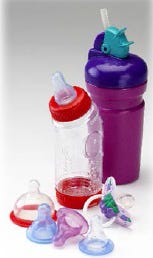Low-volatile-content silicone eliminates need for post curing
Many silicone molders post-cure molded products for up to four hours at 400°F to meet regulatory and consumer requirements for low volatile content, adding time and energy and, thus, cost to the manufacturing process. Japan's Shin-Etsu Chemical Co. Ltd. has developed a product line formulated and manufactured to reduce the level of low molecular weight siloxane (DN) volatile content, allowing molders to eliminate the post-curing process. Its subsidiary, Shin-Etsu Silicones of America (Akron, OH), is presenting the new Low DN LIMS line at NPE2015 (W-7877).
March 25, 2015
Many silicone molders post-cure molded products for up to four hours at 400°F to meet regulatory and consumer requirements for low volatile content, adding time and energy and, thus, cost to the manufacturing process. Japan's Shin-Etsu Chemical Co. Ltd. has developed a product line formulated and manufactured to reduce the level of low molecular weight siloxane (DN) volatile content, allowing molders to eliminate the post-curing process. Its subsidiary, Shin-Etsu Silicones of America (Akron, OH), is presenting the new Low DN LIMS line at NPE2015 (W-7877).
 Manufacturers of children's sippy cups and baby bottles for the European market, notably, must comply with EU standard EN 14350, which specifies a maximum weight loss (volatile content) of 0.5%. "This level typically can only be achieved by lengthy post curing," says Eric Bishop, Shin-Etsu's North America Marketing Manager, who is manning the booth at NPE. "I'm not aware of any silicone other than the DM LIMS line that can meet this specification without post curing."
Manufacturers of children's sippy cups and baby bottles for the European market, notably, must comply with EU standard EN 14350, which specifies a maximum weight loss (volatile content) of 0.5%. "This level typically can only be achieved by lengthy post curing," says Eric Bishop, Shin-Etsu's North America Marketing Manager, who is manning the booth at NPE. "I'm not aware of any silicone other than the DM LIMS line that can meet this specification without post curing."
Tests conducted by the company indicate that the average weight loss in the KEG2003H line, measured according to EN 14350, is 0.3%. "This product is now with customers who are doing their own independent testing," notes Bishop. "We are confident that they will achieve similar results."
Medical molders are keenly interested in this material, Bishop adds. "They look for heightened levels of purity in their materials just to be on the safe side. So, even if they don't need to do any post curing to achieve the levels dictated by medical device regulations, they tend to err on the side of caution," says Bishop. This adds cost, however, and is the antithesis of lean processes. "Instead of molding, packaging and shipping the parts, the manufacturer needs to manually transfer them to and from the ovens, which breaks up the smooth production flow," says Bishop.
The product line was introduced in Europe in 2014, where numerous customers have qualified KEG2003H to take advantage of the cost savings, according to the company. It is available in hardnesses ranging from 30 to 70 Shore A.
About the Author(s)
You May Also Like




